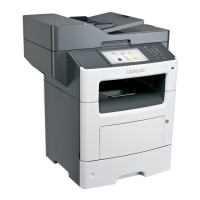For areas with die‑cuts or perforations that create a small end product, or where die‑cuts or perforations intersect, ties
on the corners of the design provide added stability. Ties may be located anywhere along perforations or die‑cuts. For
pressure‑sensitive products, ties help prevent the labels from peeling off the liner while in the printer. Ties cannot,
however, be used to compensate for inadequate release strength of the adhesive in label designs.
For specific perforation and die‑cut guidelines for your printer, locate your printer in the “Printer specifications” chapter.
Debossing and embossing
Avoid debossing and embossing materials. Embossing leads to nesting and double‑sheet feeds, and the fusing process
significantly reduces the height of the raised image. Printing too close to embossments results in poor print quality and
poor fuse grade.
Metallics
We do not recommend using metallics in forms, whether in inks or other materials, due to their conductivity and their
ability to bleed charge. This can interfere with toner transfer and cause poor print quality.
Basic form design
When designing forms, include a non‑print area of 8.38 mm (0.33 in.) at the top and bottom of the form and 6.35 mm
(0.25 in.) on both sides of the form.
In general, portrait orientation is the preferred layout, especially if you are printing bar codes. If your forms require
landscape orientation, be aware that variations in paper path speed may produce spacing variations when printing bar
codes.
Note: We do not warrant uninterrupted or error‑free operation of a product. Warranty service does not include
repair of failures caused by:
• modification or attachments
• accidents or misuse
• unsuitable physical or operating environment
• maintenance by any unauthorized (non‑Lexmark) servicer
• operation of a product beyond the limit of its duty cycle
• failure to have installed a maintenance kit as specified (if applicable)
• use of printing media outside of Lexmark specifications
• use of non‑Lexmark supplies (such as toner cartridges and/or inkjet cartridges)
• use of non‑Lexmark product or component
Pick roller technology
Some printers have an auto compensator which feeds paper more reliably than the corner buckler system used by
earlier printer models. The auto compensator has two rollers that touch the media. Avoid placing deep perforations in
these areas since the media may nest, causing multiple sheets to feed. Perforations that could cause nesting and tenting
should fall outside the pick roller area on the leading edge of the media. This is different from the 0.50‑inch space we
recommend leaving at the top of the form for printers with a corner buckler system. You may want to use micro‑perfs
to avoid nesting problems. For more information, see “Perforations and die‑cuts” on page 10.
General information 11

